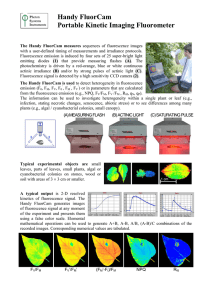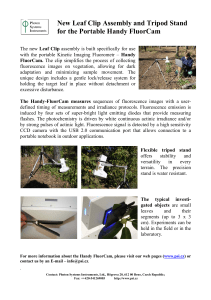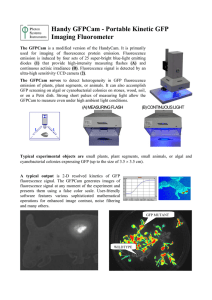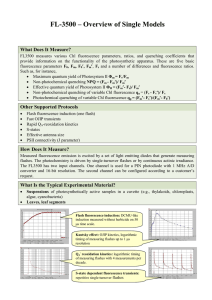Micro-FluorCam Fluorescence Kinetic Microscope
advertisement
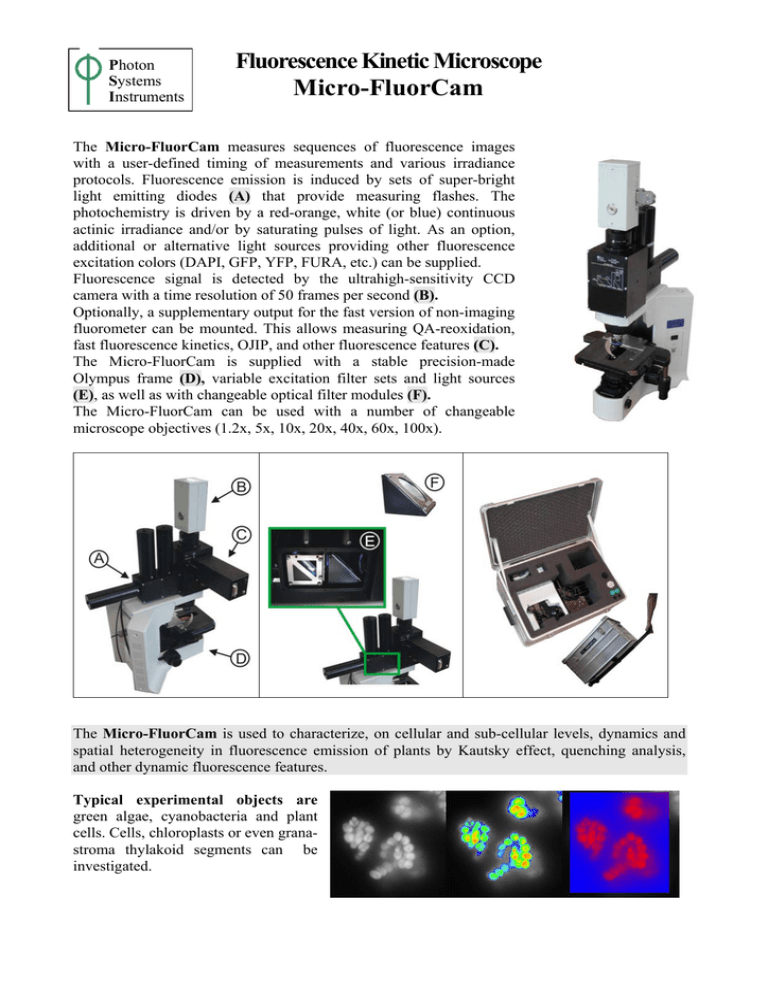
Photon Systems Instruments Fluorescence Kinetic Microscope Micro-FluorCam The Micro-FluorCam measures sequences of fluorescence images with a user-defined timing of measurements and various irradiance protocols. Fluorescence emission is induced by sets of super-bright light emitting diodes (A) that provide measuring flashes. The photochemistry is driven by a red-orange, white (or blue) continuous actinic irradiance and/or by saturating pulses of light. As an option, additional or alternative light sources providing other fluorescence excitation colors (DAPI, GFP, YFP, FURA, etc.) can be supplied. Fluorescence signal is detected by the ultrahigh-sensitivity CCD camera with a time resolution of 50 frames per second (B). Optionally, a supplementary output for the fast version of non-imaging fluorometer can be mounted. This allows measuring QA-reoxidation, fast fluorescence kinetics, OJIP, and other fluorescence features (C). The Micro-FluorCam is supplied with a stable precision-made Olympus frame (D), variable excitation filter sets and light sources (E), as well as with changeable optical filter modules (F). The Micro-FluorCam can be used with a number of changeable microscope objectives (1.2x, 5x, 10x, 20x, 40x, 60x, 100x). The Micro-FluorCam is used to characterize, on cellular and sub-cellular levels, dynamics and spatial heterogeneity in fluorescence emission of plants by Kautsky effect, quenching analysis, and other dynamic fluorescence features. Typical experimental objects are green algae, cyanobacteria and plant cells. Cells, chloroplasts or even granastroma thylakoid segments can be investigated. A typical output is 2-D resolved kinetics of fluorescence signal. The Micro-FluorCam generates images of fluorescence signal at any moment of the experiment and presents them using a false color scale. Elemental mathematical operations can be used to generate A+B, A-B, A/B, (A-B)/C combinations of the recorded images. Corresponding numerical values are tabulated. All conventional fluorescence parameters, F0, FM, FV, F0', FM', FV', NPQ, ΦPSII, FV/FM, FV'/FM', RFd, qN, qP, and other, can be mapped with resolution reaching to optical diffraction limit. TECHNICAL SPECIFICATION: The Instrument consists of a CCD camera, microscope frame, optical compartment, easily interchangeable filter sets, and excitation light sources. The CCD Camera captures 512 × 512 pixel images of 12-bit grey scale with a maximum frequency of 50 frames per second. The images are recorded synchronously with measuring light flashes. Light Sources: Measuring flashes and continuous actinic light are generated in the light emitting diodes. Different LED colors can be installed. Measuring flash duration is 10 µs - 100 µs. Continuous actinic light and saturating flashes are adjustable in duration and power. Software: The instrument is controlled by the FluorCam software that is Windows 2000/XP or higher compatible. The software enables: • Designing and/or to modifying experimental protocols, i.e., the user can control timing, duration, and intensity of the light sources as well as the camera operation. • Performing intelligent image segmentation and displaying fluorescence kinetics of the selected image segments. • Subtracting background signals and averaging the images to improve the signal to noise ratio. • Combining images taken in the different phases of transients by the use of arithmetic operations, such as, subtraction, addition, or division. FV, FV/FM, qP, qN, NPQ, Rfd, and other fluorescence parameters can be calculated to generate a table of calculated numeric characteristics for each of the selected objects (FV, FV/FM, qP, qN, NPQ, etc.). • Generating tables from the calculated numeric characteristics for each of the selected objects. Computing: A high-end computer with the USB 2.0 interface and the FluorCam software are included. PSI (Photon Systems Instruments), Ltd., Högrova 20, 612 00 Brno, Czech Republic Fax: ++420 541269005 http://www.psi.cz
